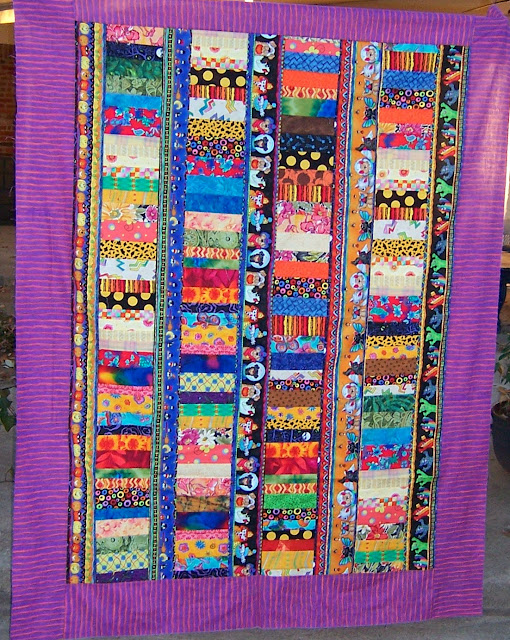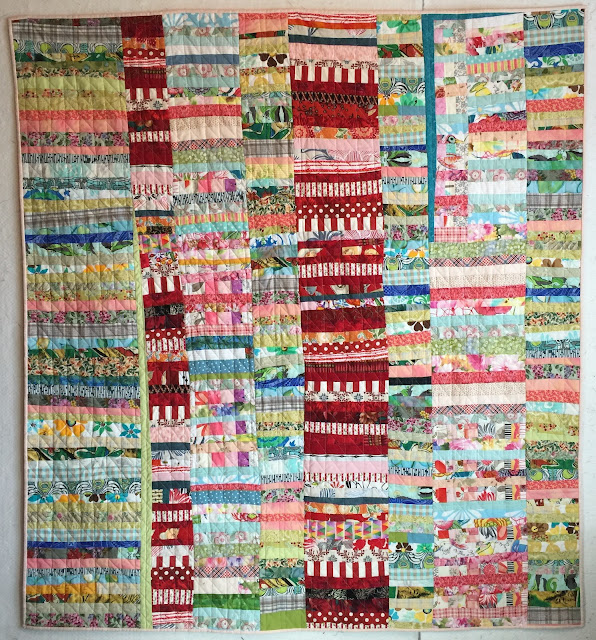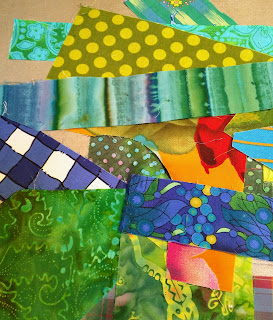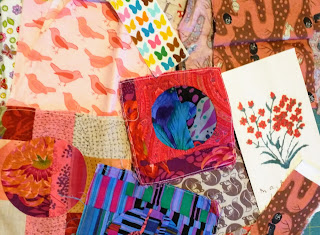Several changes make me happier with this quilt. First, pulling some of the wider small triangles creates a more uniform narrow strip. Now it doesn't look so chaotic. More may come out. {There are probably enough leftovers for a new quilt. Sigh.}
I rotated the sawtooth borders so the yellow was on the outside. While it may look better against the toile, it's too dark against the applique vine. At least, it is for me.
 |
| Spiderweb quilt with Sawtooth border, yellow to outside. |
I tried, without luck, to find something on hand for another narrow border. All the colors that might work are very short, not enough to go around. That worked for the vine border but I'm not ready to to carry it another round.
So I forged ahead with a second sawtooth border. This one is composed of 5" by 7.5" triangles cut casually around thirty degrees. The background fabrics are light greens this time. Even in this poor lighting, the color change emphasizes the yellows in the narrow sawtooth border while the size change balances the borders. And I like busy.
 |
| Spiderweb quilt with possible sawtooth borders pinned |
Everything is still in rectangles but I feel more confident about sewing the borders. I'm more secure that I don't want another floater border. It would divide these into discrete rows which might make their improvisational character a distraction instead of a feature. Does that make sense? If everything was neat and tidy then floaters would highlight that aspect. Although scrappy, the spiderwebs are neat and regular. The color changes make your eyes move; the floater stops them.
The quilt fills the entire wall but the room is too small to take a full photo.
#AHIQChineseCoins
As soon as this is sewn I plan to pull fabric for #AHIQChineseCoins. I notice Julie's well into construction. What about you?
I've been looking over my Chinese Coins Pinterest board for a month now {Yeah, I started before everyone else} and several groupings come to mind. First is a "boxing" effect caused by using sashing fabric as some of the coins. Look at these examples.
Oldest is this 1930s Pennsylvania Amish quilt on this page. (The first link goes to a photo but the second goes to the site where it is published. The quilt is almost at the bottom but the entire article is enlightening.) She only used two fabrics. I see hints of both old Venetian blinds in an abandoned room and conversely, exotically folded fabrics such as Rami Kim creates.
Another 1930s example is this homespun Chinese Coins collected by Roberta Horton. (Again, first link = photo, second link = website.) The sashings are tan plaids. I'm not sure that any were used as coins but somehow there's a hint of "boxing" to me. And I admire the way the coins are all cut from plaids on the diagonal.
By using bright red sashing and a triple border, Jane Weston created a boxed feeling without using any of the sashing fabric as coins. The few, deliberately softer reds she chose as coins contribute to the "boxing" but I think the border is the biggest factor. Try covering up the border yourself to see what a difference it makes.
Finally, Summer Reading by Timna Tarr. By merely rotating her design ninety degrees she made the boxing effect into beautiful bookcases. {I love her color sense, too.}
Enjoy the day, Ann





















